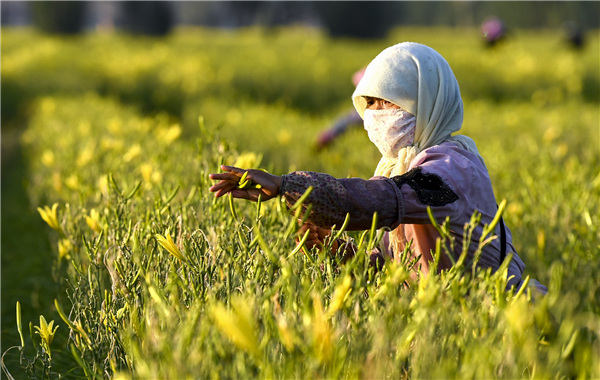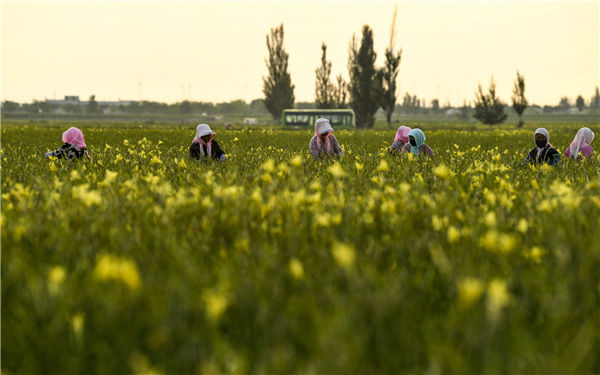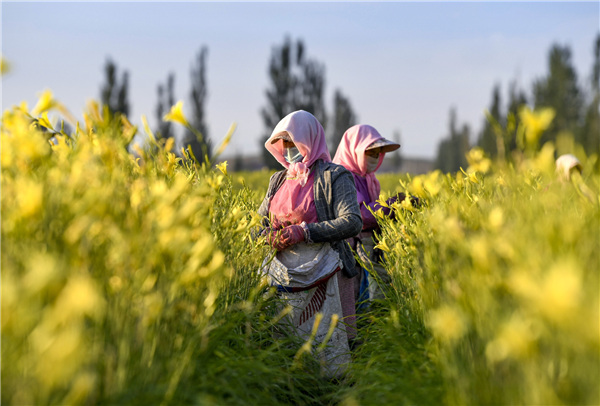Daylily Flowers Nourish Dry Land, Life
 |
| By growing drought-resistant plants such as daylily flowers, local farmers have created a greener landscape while ensuring a bountiful harvest, Daba Village, Yanchi County, Northwest China's Ningxia Hui Autonomous Region. [Xinhua] |
In the darkness before dawn, little lights can be seen moving slowly across the landscape, flickering like stars. They are, in fact, the headlamps of workers picking edible flowers for dining tables across the country.
The fields are in Daba Village, Yanchi County, Northwest China's Ningxia Hui Autonomous Region, and the flower is the daylily. Planted on 320 hectares of farmland — equivalent to 450 soccer fields — the daylilies will be disinfected by steaming, then dried and delivered to customers for consumption.
Located on the southern edge of the Muus Sandland, one of the largest expanses of sandy soil in China, Yanchi was once counted among the country's poorest counties. Annual precipitation in the county is only 280 mm, which is much less than the average precipitation for China as a whole, which stood at 645.5 mm in 2019.
By growing drought-resistant plants such as daylily flowers, local farmers have created a greener landscape while ensuring a bountiful harvest.
Su Yuan, 28, gets up at 2 am every day, takes the shuttle bus organized by the daylily farm and picks flowers till noon.
"We have to finish picking by noon, as the flowers become inedible once they are in full bloom," she said.
Su is a kindergarten teacher in the neighboring county of Tongxin. With school suspended due to the COVID-19 epidemic, she has been furloughed for some time, and the daylily picking provides a valuable extra source of income.
 |
| By growing drought-resistant plants such as daylily flowers, local farmers have created a greener landscape while ensuring a bountiful harvest, Daba Village, Yanchi County, Northwest China's Ningxia Hui Autonomous Region. [Xinhua] |
"Daylilies are about the same height as people, so there's no need to bend over to pick the flowers. It's not very tiring work, but I've got suntanned hands recently," she said.
Su makes 2 yuan (about 28 US cents) for every kilo of flowers she picks, bringing home about 100 yuan every day.
The harvesting season lasts from late June to early August, during which time there are up to 15,000 flower pickers working in the county, out on the farmland at the same time each day.
Local daylily grower Zhang Wanfeng hires nearly 40 workers for his 3.3-hectare daylily farm. Sleeping only three or four hours a day, Zhang is constantly busy, driving the workers to the farm after midnight, then weighing, steaming and drying the picked flowers or putting them into cold storage in the daytime.
He says that, in the past, the flower pickers were mainly non-locals and high-school or university students on vacation. This year, however, things are a little different.
"This year, with the epidemic mostly stopping non-local workers from coming, I mainly hire nearby villagers and those who haven't resumed work," he said.
The farm brings Zhang profits of between 75,000 yuan and 150,000 yuan per hectare.
"By growing daylilies, farmers from our village have turned their shabby adobe houses into brick ones, and almost every household has a car now," he said.
 |
| By growing drought-resistant plants such as daylily flowers, local farmers have created a greener landscape while ensuring a bountiful harvest, Daba Village, Yanchi County, Northwest China's Ningxia Hui Autonomous Region. [Xinhua] |
By the end of 2019, more than 5,300 hectares had been planted with daylilies in Yanchi. More than 3,000 local households were growing the flowers, with each household increasing its annual income by over 20,000 yuan, according to Cao Jun, head of the county's bureau of agriculture and rural affairs.
With its core industries of daylily cultivation, growing coarse cereals and sheep farming, Yanchi in 2018 became the first county in Ningxia to be removed from the list of state-level impoverished counties.
Having strong roots, the daylily plants are also helpful for windbreaking and sand fixation, as well as conservation of water and soil, according to Cao.
To save water, the local government in 2014 started promoting water-saving irrigation technologies, with drip pipes installed on farmland.
Sun Feng, deputy chief of the county's water authority, said that water-saving methods, such as drip irrigation, had been used for 97 percent of the county's irrigated area by the end of 2019.
"Drip irrigation has increased the average yield of daylily flowers by 20 percent," Sun said.
With the arrival of the daylily and the increase in incomes, local people have been able to think about more than just making ends meet. Many are now contemplating enjoying the finer things of life, such as tourism.
Zhang, the daylily grower, has decided to take a break once the harvesting season is over.
"I plan to take my family on a trip out of town for some sightseeing," he said.
(Source: Xinhua)
Please understand that womenofchina.cn,a non-profit, information-communication website, cannot reach every writer before using articles and images. For copyright issues, please contact us by emailing: website@womenofchina.cn. The articles published and opinions expressed on this website represent the opinions of writers and are not necessarily shared by womenofchina.cn.


 京公网安备 11010102004314号
京公网安备 11010102004314号